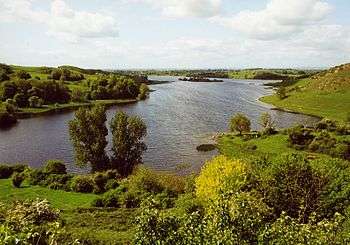
Lough Gur
Lough Gur (Irish: Loch Gair) is a lake in County Limerick, Ireland between the towns of Herbertstown and Bruff. The lake forms a horseshoe shape at the base of Knockadoon Hill and some rugged elevated countryside. It is one of Ireland's most important archaeological sites. Humans have lived near Lough Gur since about 3000 BC and there are numerous megalithic remains there.
Grange stone circle (the largest stone circle in Ireland) and a dolmen are located near the lake. The remains of at least three crannogs are present, and remains of Stone Age houses have been unearthed (the house outlines are known as "The Spectacles"). A number of ring forts are found in the area, with one hill fort overlooking the lake. Some are Irish national monuments.
A visitors' centre is open beside Lough Gur, along with a car park and picnic area. A gradual shore-line is present at the visitor area, with a shallow section of lake reaching up to the maintained lawn. As a result, the area is often used for water sports, though motorised craft are banned on the lake.
Gur
Gur or GUR can refer to:
People
Places
Other

Gurúè
Gurúè (also spelt Gurué; known before independence as Vila Junqueiro) is a town located in the northern part of Mozambique, near the center of the province of Zambezia. It is the country's largest tea estate. Population as of the 1997 census was 99,325, but current estimates are 116 922.
History
Portuguese rule

Ger (Hasidic dynasty)
Ger, or Gur (or Gerrer when used as an adjective) is a Hasidic dynasty originating from Ger, the Yiddish name of Góra Kalwaria, a small town in Poland. The founder of the dynasty was Rabbi Yitzchak Meir Alter (1798–1866), known as the Chiddushei HaRim after his primary scholarly work by that title.
Prior to the Holocaust, followers of Ger were estimated to numbered in excess of 100,000, making it one of the largest and most influential Hasidic groups in Poland. Today the movement is based in Jerusalem and its membership is estimated at 13,000 families, most of whom live in Israel, making the largest Hasidic dynasty in Israel. However, there are also well established Ger communities in Brooklyn NY and London UK, and minor Ger communities in Toronto Canada and Los Angeles CA.
History
After the death of the Kotzker Rebbe in 1859, the vast majority of his Hasidim chose Rabbi Yitzchak Meir Alter, the Kotzker Rebbe's brother-in-law and his closest disciple, as their new rebbe. At the time, Rabbi Yitzchak Meir lived in Warsaw and led the main Kotzker shtiebel there (on ul. Zelazna). Shortly after accepting the leadership of the Kotzker Rebbe's Hasidim, Rabbi Yitzchak Meir was appointed as Rav and Av Beit Din (head of the rabbinical court) of Ger. Relocating to Ger, he became the founding rebbe of the Gerrer dynasty. During his seven years of leadership, the Chassidus flourished, causing it to be known as the "seven years of plenty".
Podcasts:

-
by Love Affair
-
by Love Affair
-
by Love Affair
-
by Love Affair
-
by Love Affair
-
by Love Affair
-
by Love Affair
-
by Love Affair
-
by Levi Weaver
-
by Levi Weaver
-
by Levi Weaver
-
by Levi Weaver
-
by Lofofora
-
by Lofofora
-
by Lofofora
-
by Lofofora
-
by Lofofora
-
by Lofofora
-
by Lofofora
-
by Lofofora
-
by Lofofora
-
by Lofofora
-
by Lofofora
-
by Lofofora
-
by Lofofora
-
by Lofofora
-
by Lofofora
-
by Lofofora
-
by Lofofora
Bringing On Back The Good Times
by: Love AffairSince you went away I've been losing my sleep at night
Never thought there 'd come a day
when you'd be back to make everything right,
but how wrong could I be
'Cos now you're here with me
Bringing on back the good times,
taking away the pain.
You're bringing on back the good times
and I'm living on air,
So glad that you're there,
sweeping away the sad times,
making me laugh again
I've never been loved by anybody
that's quite like you,
So when you're telling me
of all the things you want me to do,
now you've made me see
what you mean to me
